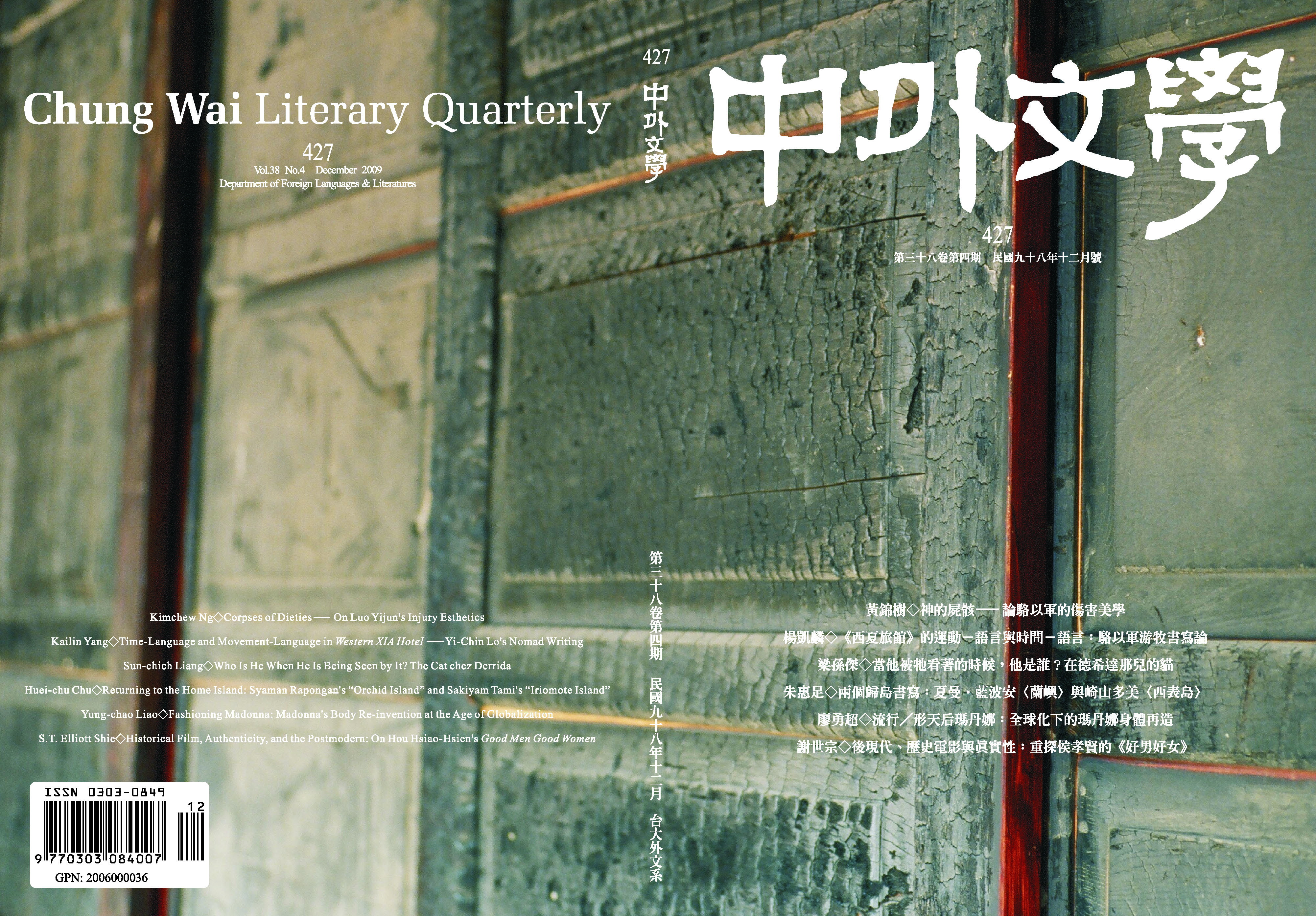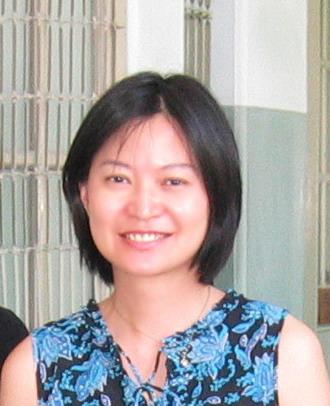第三十八卷 第四期 總427 中華民國98年12月
Vol.38 No.4 December 2009

《中外文學》十二月號收錄六篇精彩論文:黃錦樹以嬰屍詮釋學的角度,對駱以軍的《西夏旅館》做考古追蹤,佐以《遣悲懷》的詮釋,描繪出駱以軍「傷害美學」的形成及演化;楊凱麟以德勒茲(Gilles Deleuze)與瓜達希(Félix Guattari)的游牧書寫概念來解析駱以軍《西夏旅館》中的書寫特異性;梁孫傑主張德希達(Jacques Derrida)以它者的眼光省視並呈現動物,探索德希達處理動物回視時所觸及的種種問題;朱惠足討論蘭嶼原住民作家夏曼‧藍波安的散文〈海洋朝聖者〉與沖繩西表島崎山多美的小說〈水上往還〉,探討兩位離島作家的歸島書寫;廖勇超討論全球化下瑪丹娜做為一種商品與身體影像的互相形塑,以及其中「身體曲線」與「經濟曲線」的構連性;謝世宗則探究侯孝賢電影《好男好女》中電影歷史敘事與真實性的相關議題。
中外文學十二月號目錄
Contents
黃錦樹╱神的屍骸 ──論駱以軍的傷害美學
神的屍骸 ──論駱以軍的傷害美學
黃錦樹*
摘要
◎關鍵詞:傷害,屍骸,夢,時差,神
★國立暨南國際大學中國語文學系教授。
Kimchew Ng╱Corpses of Deities— On Luo Yijun’s Injury Esthetics
Corpses of Deities— On Luo Yijun’s Injury Esthetics
Kimchew Ng*
Abstract
◎Keywords: injury, corpse, dream, jet lag, deities
★Professor, Department of Chinese Language and Literature, National Chi Nan University.
楊凱麟╱《西夏旅館》的運動-語言與時間-語言: 駱以軍游牧書寫論
《西夏旅館》的運動-語言與時間-語言
駱以軍游牧書寫論
楊凱麟*
摘要
◎關鍵詞:駱以軍,《西夏旅館》,虛構,時間-語言,運動-語言,故事
★國立中山大學哲學研究所副教授。
Kailin Yang╱Time-Language and Movement-Language in Western XIA Hotel —Yi-Chin Lo’s Nomad Writing
Time-Language and Movement-Language in Western XIA Hotel —Yi-Chin Lo’s Nomad Writing
Kailin Yang*
Abstract
◎Keywords: Yi-Chun Ro, Western Xia Hotel, fiction, time-language, movement-language, story
★ Associate Professor, Institute of Philosophy, National Sun Yat-Sen University.
梁孫傑╱當他被牠看著的時候,他是誰? 在德希達那兒的貓
當他被牠看著的時候,他是誰?
在德希達那兒的貓
梁孫傑*
摘要
◎關鍵詞:德希達,動物,視覺,深淵,延異,中動語態,字動物
★國立臺灣師範大學英語學系副教授。
Sun-chieh Liang╱Who Is He When He Is Being Seen by It? The Cat chez Derrida
Who Is He When He Is Being Seen by It?
The Cat chez Derrida
Sun-chieh Liang*
Abstract
◎Keywords: Derrida, animal, vision, abyss, différance, middle voice, l’animot
★Associate Professor, Department of English, National Taiwan Normal University.
朱惠足╱兩個歸島書寫: 夏曼.藍波安(蘭嶼)與崎山多美(西表島)
兩個歸島書寫
夏曼.藍波安(蘭嶼)與崎山多美(西表島)
朱惠足*
摘要
◎關鍵詞:夏曼‧藍波安,崎山多美,蘭嶼,西表島,離島
★國立中興大學台灣文學研究所助理教授。
Huei-chu Chu╱Returning to the Home Island: Syaman Rapongan’s “Orchid Island” and Sakiyam Tami’s “Iriomote Island”
Returning to the Home Island
Syaman Rapongan’s “Orchid Island” and Sakiyam Tami’s “Iriomote Island”
Huei-chu Chu*
Abstract
◎Keywords: Syaman Rapongan, Sakiyam Tami, Orchid Island, Iriomote Island, offshore islet
★Assistant Professor, Graduate Institute of Taiwan Literature, National Chung-Hsing University.
廖勇超╱流行/形天后瑪丹娜: 全球化下的瑪丹娜身體再造
流行/形天后瑪丹娜
全球化下的瑪丹娜身體再造
廖勇超*
摘要
◎關鍵詞:瑪丹娜,瑪丹娜研究,全球化,身體,商品,布希亞,流行音樂,數位化
★國立臺灣大學外國語文學系助理教授。
Yung-chao Liao╱Fashioning Madonna: Madonna’s Body Re-invention at the Age of Globalization
Fashioning Madonna
Madonna’s Body Re-invention at the Age of Globalization
Yung-chao Liao*
Abstract
◎Keywords: Madonna, Madonna Studies, globalization, body, commodity, Jean Baudrillard, popular music, digitalization
★Assistant Professor, Department of Foreign Languages and Literatures, National Taiwan University.
謝世宗╱後現代、歷史電影與真實性: 重探侯孝賢的《好男好女》
後現代、歷史電影與真實性
重探侯孝賢的《好男好女》
謝世宗*
摘要
◎關鍵詞:後現代,侯孝賢,《好男好女》,歷史電影,真實性
★國立清華大學台灣文學研究所助理教授。
S.T. Elliott Shie╱Historical Film, Authenticity, and the Postmodern: On Hou Hsiao-Hsien’s Good Men Good Women
Historical Film, Authenticity, and the Postmodern
On Hou Hsiao-Hsien’s Good Men Good Women
S.T. Elliott Shie*
Abstract
◎Keywords: postmodern, historical film, authenticity, Hou Hsiao-hsien, Good Men Good Women
★Assistant Professor, Graduate Institute of Taiwan Literature, National Tsing Hua University.


